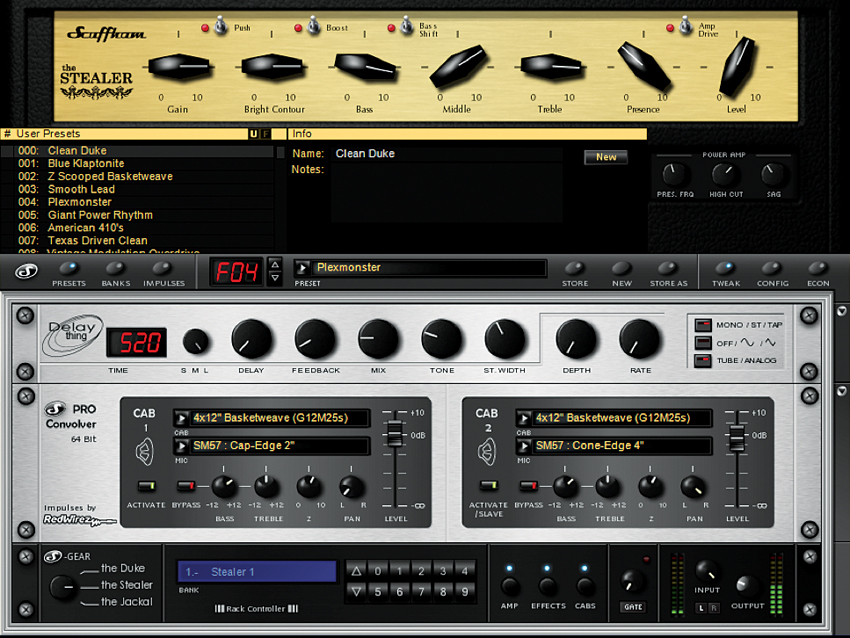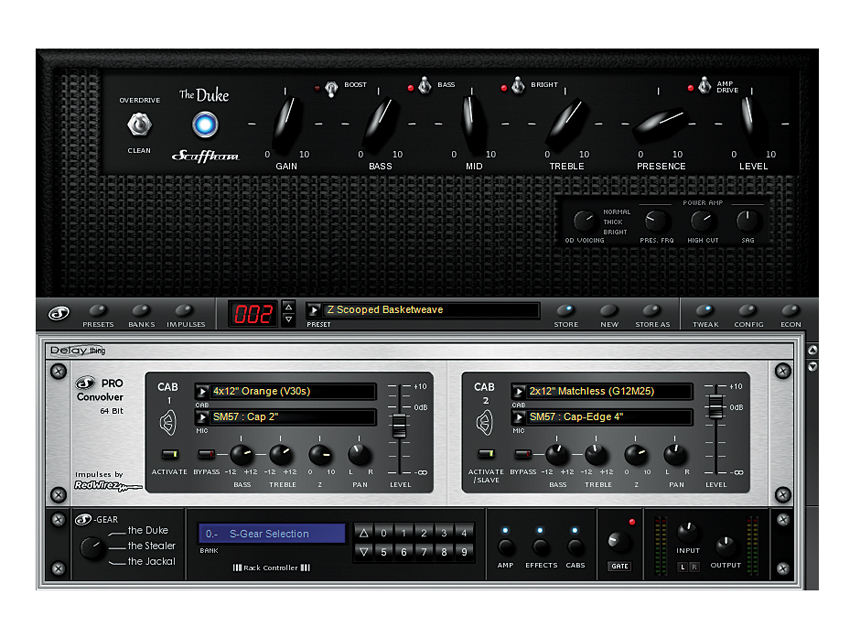MusicRadar Verdict
Blues hounds and classic rockers will be unable to suppress their urge to gurn when they clap ears on S-Gear's golden tones.
Pros
- +
Superbly user-friendly interface. Excels at clean, blues and rock tones. Affordable. Standalone version included. Great RedWirez cabinet impulses.
Cons
- -
No tuner. No effects/pedals besides delay. High-gain tones aren't so hot.
MusicRadar's got your back

Scuffham Amps S-Gear

Scuffham Amps S-Gear
Coming straight outta Estonia is newcomer Scuffham Amps. The company is headed up by Mike Scuffham, a former product designer for arguably the biggest guitar amp company of all time - Marshall.
Mike was the brains behind one of the front-runners of the rack-mounted preamp revolution, the Marshall JMP-1; lending his contribution to the plug-in world an air of considerable credibility.
"The simplicity of approach - focusing on quality rather than quantity - gives S-Gear a particular charm."
S-Gear runs standalone or as a VST plug-in. It's Windows-only at the time of writing, but a Mac version is said to be imminent.
Similar to the general design ethos of say, Magix' Vandal and Kansas's Amplifikation One, Scuffham Amps is not claiming accurate emulations of familiar gear. Rather, S-Gear draws inspiration from the best pre/power amp tube models available and channels this into original amp models.
S-Gear contains three amps: The Duke, The Stealer and The Jackal. This might seem stingy compared to, say, AmpliTube, with its extensive lineup of amps - but this would be missing the point of S-Gear entirely, which is streamlined simplicity and quality over quantity.
This concept is reflected in the plug-in's interface, too. Despite having a simple, functional noise gate, S-Gear hasn't got a tuner, doesn't feature any stompboxes (although the Amp Drive switch on the input has a similar impact to a pedal), features delay but not reverb, chorus, and so on, and is missing a bass amp.
However, these omissions means that all elements of the tonal chain - from amp to mic - can be viewed at once, making operation quick and unconvoluted. The delay effect and cabinet simulation section can both be hidden from view if you need to conserve screen space.
From our perspective, this simplicity of approach - focusing on the quality of what it does have, rather than on quantity of features - gives S-Gear a particular charm. It means you focus on playing, rather than tweaking a seemingly infinite variety of options.
Aural pleasure
So, how does it sound? Firstly, it must be said how much of a delight it was to find so many of the factory presets to be entirely usable without the need for serious tweakage.
It makes us question why so many other amp sim developers can't provide the same - after all, it's not uncommon for amp sim presets to be utterly unusable without major surgery.
The Plexmonster preset, for example, is an immediate winner, with an incredibly musical timbre and such a realism of response that we quickly forgot that we were using a plug-in (this is surely the Holy Grail that amp sim developers are striving for!).
This preset uses the Stealer amp and is arguably the most realistic classic Marshall sound that we've encountered in software. For naturally warm-sounding crunch rhythm tones and solos, it's hard to beat.
Duke forever
The Duke is a medium-gain amp more suited to cleaner tones, and it's perfect for crunchy rock 'n' roll and lower-gain blues tones. To be fair, most other amps sims have these tones fairly well covered too.
At the grittier end of the gain spectrum lurks The Jackal, which is akin to modern, high-gain amps such as those made by Soldano. Following a few slightly downtuned Alice in Chains licks and some galloping thrash metal riffage, it became apparent that The Jackal's response and character aren't particularly well suited to these styles.
This was despite numerous tweaks to the presence frequency, high-cut and sag parameters of the power amp, and various cab/speaker and mic combinations. The response and low-end weight and tightness required just weren't quite there.
It's impressive how the characters of all three S-Gear amps respond when you back off the guitar's volume control. With the volume edged back to, say, a quarter, a fairly clean tone with a bit of edge can be had; but those elusive tones from Gary Moore's Still Got The Blues album can be found by cranking it up a little more.
Then, by experimenting with the Push, Boost and amp Drive switches, as well as the gain and tone controls (based on traditional passive designs), you can take it from Texas blues to classic British rock, or from BB King on through to ZZ Top. It's stunningly done, and then some.
The devil is in the detail
Scuffham claims to offer some of the most sophisticated, detailed speaker cabinet sims on the market in the form of S-Gear's convolution-based Pro Convolver.
Some software packages offer seemingly endless options, but there are just seven cab options in the Pro Convolver section (all impulses provided by the excellent RedWirez), as well as the ability to source and load your own. Additionally, there are simple bass and treble parameters in the cab/mic section.
One of the Pro Convolver's more unique features is the ability to manipulate the effect of speaker impedance via its 'Z' control, and very effective it is, too. For mics, there's a dynamic Shure SM57 and ribbon Beyer Dynamic M160 in the virtual swag bag, each with four positions to choose from.
These all tend to provide exactly what's needed rather than giving you hundreds of combinations, often creating option anxiety in the process. From here, you have the option to engage the second convolver channel to layer up two cab/mic setups.
Going for the same cab but with two different mics panned in stereo is an effective approach; alternatively, you could experiment with different cab and mic combinations to create your own unique sounds.
Delays ahead!
As mentioned earlier, S-Gear has but one effects module: the sophisticated and highly effective Delay Thing. Here, the atmospheric tones of analogue delay pedals are emulated to impressive effect.
You can even choose to use tube simulation circuitry, which provides extra harmonics and warmth while still retaining transparency. As Scuffham Amps rightly claim, the Delay Thing is capable of a wide variety of sounds, and any David Gilmour/Floyd aficionado will undoubtedly be well pleased with this aspect of the software.
For those concerned about CPU usage, there's an economy mode that proves very effective at conserving CPU power and doesn't affect sound quality too much either.
To conclude, S-Gear is most suited to blues, rock 'n' roll and classic rock, as opposed to the metal end of the genre spectrum. When played to its strengths, though, S-Gear is a simply stunning success.
Now listen to our audio demos to hear S-Gear in action:
Computer Music magazine is the world’s best selling publication dedicated solely to making great music with your Mac or PC computer. Each issue it brings its lucky readers the best in cutting-edge tutorials, need-to-know, expert software reviews and even all the tools you actually need to make great music today, courtesy of our legendary CM Plugin Suite.
With its latest free update, Ableton has finally turned Note into the app I always wanted it to be
Technically capable, but struggle to make your tunes sound musical? 5 simple music theory hacks to make your tracks stand out
"Despite its size, it delivers impressive audio quality and premium functions as well as featuring a good selection of inspired sounds": Roland GO:Piano 88PX review










